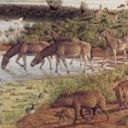
| Palaeos: |  |
Deep Time |
| Time | Deep Time |
|
Cosmological time Geological Time Quaternary Time Historical Time Future Time |
Time
Logarithmic Timescales Cosmic Calendar Geological Timescales |
In order to understand the history of life on Earth, we need to understand Deep Time. Deep Time - the idea that the Earth and the universe are not merely thousands, but millions, or even billions, of years old, was only discovered in the Western world with the birth of the science of geology through figures such as Hutton and Lyell, although even more radical ideas of a literally beginningless universe have been standard to Eastern philosophy (Jainism, Buddhism, and Hinduism) for several millennia. Both Western geological, and Eastern, ideas were however uniformitarian; the past was assumed to be just like the present. Lyell for example resisted contemporary ideas of transformation of life. It was only with Darwin's great revolutionary insight of evolutionary naturalism that we had not only deep time but the idea of change and evolution as well.
In order to give an example of deep time I have drawn up a table, which uses a quasi-logarithmic timescale, but not a true logarithmic timeline because here each successive time unit or increment does not follow after, but includes the immediately preceeding one, only it is an order a magnitude larger (i.e. it includes a period ten times longer, from the past to the present). To give a sense of context, the first time increment is 6 months, which puts things in a personal frame. Ten times six months is five years, ten times that is fifty. And so on. Different levels are coloured coded, according to whether the timescale is current, historical, Quaternary", Geological, or Cosmological. Transitional levels are indicated by alternating colours:
| Representative image | Increment in Years | Extent | Type of timeline | Representative events |
 |
6 months | (half a) Year | Current affairs | Current events, what's happening in the world and in your life now and over the last six months. (image: CCTV Building, Beijing) |
 |
5 years | (half a) Decade | Current affairs | Basically now, current history, fads, new discoveries in science, etc; Early 21st Century (image: Dubai cityscape Real Estate East & West Meet in MIT/CRE Travel Course) |
 |
50 years | decades, (half a) century | Historical | Modern History, late 20th century and start of 21st Century. A human lifetime, pretty much. Encompasses the entire Information Revolution and the modern global social and economic order. (image: 1990s montage - Wikipedia) |
 |
500 years | Centuries | Historical | Modern History, European colonialism, modernity, the birth of science, the modern world, Industrial Revolution, accelerating technological progress, Information Revolution. (image from Patrice Pellerin Art - Harbour Boats) |
 |
5,000 years | Centuries and millennia | Historical | Human History, the entire span of civilization fits here, everything from the Bronze Age through the Iron Age through to the industrial revolution, the Space Age, and the information revolution, the rise and fall of empires and civilizations. (image from Touring Athens During the Golden Age) |
 |
50,000 years | Millennia | Quaternary | The Late Pleistocene and the entire Holocene. Almost all this period is taken up by Includes the last ice age, the Late Paleolithic, Music, Art, Cave paintings, human migration, Neanderthal flourishing and then extinction, flourishing and then sudden extinction of megafauna in various parts of the world (but not Africa or SE Asia), and right at the end the Mesolithic and Neolithic and the agriculture revolution, with civilization, religion, philosophy, monarchy, priesthood, the standing army, the monetary system, colonialism and conquest, and finally a tiny blip (half a percent of this overall period) for the rise of science, technology, and the industrial and information revolution. At 50,000 years, this could be considered the threshold of Deep Time. Here paleoclimatology, paleoanthropology, and paleontology all enter the picture. image from a Charles R. Knight painting of woolly mammoths, copied from Laelaps blog |
 |
500,000 years | Megayear | Quaternary / Geological | The Pleistocene epoch, with a tiny blip (two percent of the overall) for the Holocene and our anthropocentric perspective tacked on at the end. For almost the entire period though, this period was characterised by Pleistocene flora, fauna and megafauna, and a succession of glacials and interglacials, Both anatomically modern and Neanderthal versions of Homo are late comers (150 to 100 KYA), most hominids were archaic Homo sapiens and Homo erectus (Early Paleolithic - Acheulean). At half a million years, we are basically at the scale of geological time. Even so, this great expanse of time - a hundred times longer than all of human history - is still of a finer resolution that is generally used in Palaeos. Image: North American Pleistocene scene, thumbnail image from Who Wants a Pleistocene-Era Backyard? |
 |
5 million years | Ages | Geological | The Plio-Pleistocene; Tertiary and Quaternary mammals, global cooling, culminating in a cycle of glacials and interglacials, basically modern plants and invertebrates (or generally only differing at a species level), a number of different hominid species. Five million years or so brings us into the region of geological time, continental drift, and species lifetime (although many species have a shorter lifetime, and a few a longer), and many of the Phanerozoic timescale pages at Palaeos cover increments of around this duration, or somewhat shorter. Image: Pliocene, from The Cenozoic Era |
 |
50 million years | Geological periods | Geological | Almost the entire Cenozoic or Age of Mammals can fit here, a whole geological era (albeit the shortest one). Books on prehistoric life generally refer to periods or eras rather than epochs or ages, and as each period might last in the vicinity of fifty million years (some shorter, some longer), increments each of about this length would be used to give a general overall review of the history of complex life on Earth. In contrast to the two lower orders of magnitude given above, this is a rather coarse resolution scale; in order to follow the history of life on Earth, a rather finer division of time is required. However, fifty million years would be pretty good as unit of fine measurement for, say, the vast expanse of the Precambrian. (image Miocene Landscape, by Zdenek Burian) |
 |
500 million years | Geons and eras | Geological | Almost the entire Phanerozoic or eon of complex life can fit here - evolution from trilobites to dinosaurs to the modern world, as shown by the diorama of the Devonian reef at the left. Talking in terms of increments each of which is this long, half a billion years, can be useful for a general review of the Precambrian (which would be about eight of these units long) or cosmic history as a whole (which is more than two dozen). Precambrian eras for example are generally around three or four hundred million years long each, although the longest, the Paleoproterozoic is a whopping nine hundred million. Such long expanses of time indicate either that nothing as happening, if we assume accelerating change, or that lots was, but because it is so long ago most of the information has been lost, so we need longer and longer time periods to make up the same information. |
 |
5 billion years | Geological eons | Geological | This duration spans the entire 4.6 billion year history of the Earth and the Solar System, and has a few hundred million left over to boot. On Earth, most of which is the Precambrian world inhabited by microbes and algae mats, and probably looked a lot like the image at the left. Early in this time span, other planets in the solar system such as Mars experience brief periods of geological activity. Here the geological timescale is subsumed under Cosmology; the history of the universe as a whole. (image Proterozoic Sea - Zdenek Burian) |
 |
50 billion years | Gigayears | Cosmological | Big Bang, Stars and galaxies, Life on Earth, and elsewhere in the cosmos. Because this time increment is about three times the age of the known universe, it either has to extend back to previous universes (assuming it is meaningful to do so; presumably not, because time and space as we know them are products of this universe, or into future ages of the Stelliferous era. (image Hubble Ultra Deep Field - NASA) |
| Page Back: Deep Time | Page Top | Related: Five ages of the Universe | Page Next: Logarithmic Timescales |
content by MAK111007, edited RFVS111109
